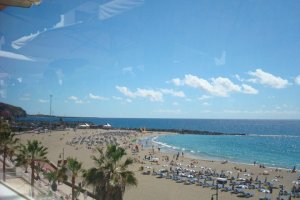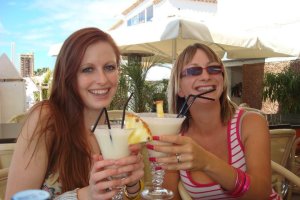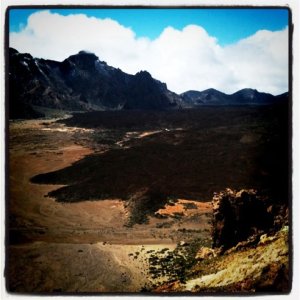You think Tenerife is all hot and tropical? Think again. It’s an amazing diverse little island with a lot more going on than you might first assume.
I headed there for a week of visiting a wonderful friend, Naomi, and got a lot more than just the hot sun and the beach. I also got snow, rain, cities, fishing villages, and volcanoes.
Tenerife has multiple microclimates. The number varies depending on who you ask, but travelling the island from North to South you need clothes for all four seasons.
Heading South for the sun
I arrived in Los Cristianos, Naomi’s neighbourhood, and got just was I was expecting (and craving after months of cold English weather) – hot sun, white beaches, swimming pools, hotels and lots of tourists. Los Cristianos isn’t quite as built up as it’s close neighbour, Las Playas de Las Americas (literally, the beaches of the Americas, or Americans), but it was still the sunny escape most of us Brits crave around this time of year.
I spent my time there filling up on paella, tapas and cocktails whenever I could, exploring the boardwalks and the tourist beaches.
How do you tell a tourist beach from a local untouched beach in Tenerife? Tenerife doesn’t have white sand, the sand here is black. All that glistening white stuff is imported from Africa just to fulfill the picture perfect beach image…fit for a postcard.
Santa Cruz: Soggy city life
Okay, I admit that Naomi insists that I managed to pick the worst week to see Santa Cruz, but I can only go with what I saw. I was there for Carnaval week, and so was ready for a day of parties in the street, with drinks and carnival food in the hot sun. What I got? Cold, grey skies, and more rain than I’d left behind in England. Less than an hour’s drive back down South in Los Cristianos, it was 30 degrees and baking. In Santa Cruz, I had a scarf and jeans on and was still cold. Having said that, Santa Cruz is a nice city, and while it’s much more built up than the rest of Tenerife, it’s worth a visit to explore. I felt like it fit somewhere in between Barcelona and Madrid, it’s mainland siblings. And I’m sure the Carnaval would have been a lot more impressive if the umbrellas hadn’t blocked most of the view… I did manage to get one quick snap in between rain clouds though.
Pico del Teide: Let it snow
One of the sites on the top of my Tenerife list was visiting Mount Teide. The highest elevation point in Spain, and one of the world’s largest volcanoes, Teide and the surrounding National Park are unmissable. You hear the word ‘lunar landscapes’ thrown around a lot when people describe this place, but, well, few things could say it better. It really is like another world. And at the elevation, forget the 30 degree heat of Los Cristianos, at this point I was even missing the chill of Santa Cruz. In Teide National Park, there was snow at my feet, not that I could feel them, and we in fact had to wait over an hour before leaving the small cafe as we couldn’t see more than 30 metres ahead of us from the snow and fog.
When we finally did get out, the paths towards the volcano were almost deserted (not that many people crazy enough to leave the beaches) which meant a peaceful light trek through some seriously strange rock formations.
Small towns and smaller children
After spending time in the capital, the tourist capital, and the highest point on the island, I got a chance to see some local Canarian life in the towns of Candelaria and La Laguna.
Naomi is an English teacher, teaching mostly very young children both in the capital and Candelaria, a much smaller town on the East Coast. Both Candelaria and La Laguna are beautiful towns well worth exploring and far away from the tourist hoards. And the children know their colours, numbers and body parts vocabulary very well…

Marianne McPhee was born in London and has been a traveler throughout her life. She spent her summers in France and Spain on a boat, her teenage years living in the USA, and months backpacking through Europe and Morocco. She has spent eight months traveling through Thailand, Laos and Cambodia where she also taught English and then ventured to Australia for more exploration. She is a graduate from Boston University and currently works in the travel industry in London.













